Introduction
This note belongs to a rather long series(1) compiled as a result of studies carried out in the Estranei section of the Archivio dell’Ospedale degli Innocenti di Firenze (AOIF). Many account books of merchants and manufacturers are kept here, and particularly of silk producers and dealers, because the Florentine Arte della Seta was the main patron of the hospital.
In this case, essential assistance I found from the studies of Florence Edler de Roover (1900-1987). She carried out long and deep studies in the Florentine archives, which mostly remained unpublished. A book on the Florentine Arte della Seta has been compiled after her death, on the basis of her research notes from the Catasto books, for various years and for many silk merchants.(2)
In 1966, she had published a thorough study on one of the most important silk manufacturers and merchants of the time, Andrea Banchi.(3) This publication is written in English and in a concise way - too tempting for me to stay away from deeply pillaging from it everything, which I can thus avoid to write myself. All the many paragraphs reported between quotation marks below are verbatim taken from her article.
1. Silk traders and silk manufactures
Entrepreneurs involved in Florence with the silk production and commerce were many and their participation could be the most various; however, a major distinction was between “setaioli grossi” and “setaioli piccoli”, namely between a few rich merchants and producers, and a greater number of retailers who were trading small quantities of silk products in their shops. Some dealers encountered in my previous studies belonged to the latter group, whereas we are now in front of one of the richest silk merchants. This requires some further information on the organisation itself of silk production at the time.
«The Florentine silk industry was not carried on in factories in the modern sense but was organized according to the putting-out system. The master manufacturer bought the raw materials, sold the finished product, and controlled all phases of the manufacturing process in between. He distributed the materials to be worked on by craftsmen or small master in their own homes or in small establishments. These materials were returned to the manufacturer’s shop after each successive operation. Warpers and weavers are good examples of craftsmen. Throwsters and dyers are examples of small masters who operated their own establishments, in which they probably employed one or more assistants.»(3)
2. Andrea Banchi’s life
«Andrea di Francesco di Banco was born September 20, 1372, and lived to be a nonagenarian, dying on October 12, 1462. Nothing is known about his early years. His father and his uncle Lodovico both died of the plague in 1390. Andrea probably worked from 1390 onward for his only surviving uncle, Michele.» «From 1421 until 1428 Andrea Banchi carried on without a partner. In the shop in Via Por S. Maria he sold silks at retail. Soon he began producing silk fabrics as well.»
«Banchi’s capital investment in his business was higher than that of most silk manufacturers in 1427, yet he was in business alone and did not have to share profits with partners nor pay interest on any deposits, as was the practice in Florence.» «At this time very few setaioli were richer than Banchi, for only three were assessed more than he.»
«In 1428 Banchi decided to expand his business activities. As an independent merchant-entrepreneur, he continued the production and sale of silk cloth. In addition, he formed a partnership with Piero d’Andrea Petrini to carry on a retail shop dealing in silk goods.»
«In 1454 Andrea Banchi formed his last partnership, which was carried on for five years after his death, in 1462, according to a provision in his testament. His partners were two employees whom he had trained and of whose ability he was reasonably certain.»
«Like other merchants of his time, Andrea Banchi acquired farms and other real estate as he prospered.» «By 1457, a few years before his death, Banchi was among the ten highest taxpayers in the entire city and second-highest in the Scala gonfalon.»(3)
3. Banchi’s production and commerce
«Some silks were sold by Banchi to merchants engaged in the import-export business, and the extant records for 1454 and later years show that about a third of the firm’s output was bought by such merchants, partly in exchange for raw silk. Banchi also tried to sell his products abroad by sending them on consignment to commission agents.»
«In any case, measured by medieval standards the Banchi firm was a large enterprise and probably gave employment to about one hundred persons, perhaps even more. In May, 1460, the staff in the shop numbered seven (besides the partners): a bookkeeper, a cashier, a clerk, and four shop boys. Outside the bottega Banchi employed five throwsters, three dyers, three warpers, four maestre and two spinners of inferior silks, about thirty winders and as many weavers, ten weavers of belts and ribbons, one designer of cartoons, and one vestment-maker - nearly one hundred persons.»
«The records show that Banchi specialized in the manufacture of luxury fabrics - brocades, figured velvets, and damasks - and produced relatively few of the less expensive satins and taffetas. This was perhaps a mistake from a pecuniary point of view because such high-priced articles had a small market and were therefore hard to sell. It is not surprising that the turnover of Banchi’s stock was slow, a problem that was often aggravated by the necessity of granting generous credit terms to customers. Andrea Banchi apparently prided himself on producing the high-quality products which had established the reputation of the Florentine silk industry.»(3)
4. Bookkeeping
«The private libro segreto of Andrea Banchi and the one for the last partnership (1454-1462) have permitted us to outline Banchi’s business career, the partnerships he formed, and the profits he reaped. However, they do not enable us to enter his silk shop and storeroom to see what raw materials he purchased and from whom; to know how production was organized, how many workers were employed, and what they were paid; and to have an accurate idea of the silk fabrics he produced, how many, and how they were sold.
Some of this information can be gathered from the other Banchi account books in the Spedale degli Innocenti, although the sets are unfortunately incomplete. Three ledgers have been preserved: the Libro rosso segnato C, which covers the period 1437 to 1454, and two ledgers that belong to the last Banchi partnership and cover successively the entire period of the partnership, 1454 to 1467, the Libro rosso A and the Libro bianco B. The books for this last period are the more complete.
Besides the two ledgers and the libro segreto of the partnership are three journals (giornali e ricordanze), two cash books (entrata e uscita), two quaderni di cassa (which are not just cash books but small ledgers that also contain petty merchandise expense accounts and accounts with bankers), one letter book (Registro di lettere, 1462-1465), and several auxiliary books.
One of the auxiliary books is entitled Entrata di lavori e mercatanzie, in which is recorded all the finished silk cloth brought from the looms and the names of the purchasers, beginning in May, 1460. There is also a Book of Shipments (Mandate di mercatanzie, 1456-1457) and a precious Book of Weavers (Libro di tessitori B), which contains not only the accounts with weavers but also those with throwsters, dyers, and warpers for the years 1458-1462. Unfortunately, three auxiliary books that contain the accounts of workers are lost.»(3)
5. The only one book of our interest
As outlined by Florence Edler de Roover, several account books of Andrea Banchi can be found in the AOIF, as one can now easily confirm with its useful inventory.(4) I have checked a remarkable part of them, but could not discover anything of our specific interest.
Some of the auxiliary items appeared as the most promising, to begin with Registro di lettere.(5) However, this book hardly contains copies of letters sent to various places, but long lists of just dates and addressees.
In conclusion, the only book, which has been of some interest for me, has been the Book of Shipments.(6) In the inventory, we read: «12574 (20/04/1456 - 10/12/1457) “Mandati di mercantie A” Relativo all'attività di Andrea di Francesco Banchi e particolarmente alle spedizioni di merci a diversi.»(4)
As its title clearly signifies, it contains lists of shipments. Of course, it is easy to imagine which these shipments were. We can even find in the main account books which were the goods sold at a given time, and search for them in this special book.
In actual practice, matters are rather different: we find much more items registered in this book than in the ledgers. It is as if this book belonged to a different merchant, or better to a shipping agent, who cared for sending to every place various goods provided by Andrea Banchi. In case of an independent shipping agent being involved, this book would be less surprising. Our surprise arises from the fact that it is Banchi himself to organise these shipments, in which his own products were a part of the whole load. The situation looks like that of a sorting centre!
Obviously, we have in general a main part of the shipment, which can be considered as the cause itself for sending the load. Let us assume it is a box of silks to be sent to Rome. Now, before the goods leave from Florence, a new question arises: what else can we send together with the silks, either addressed to Rome or to any place along the same itinerary? The way out is that we usually find strange and fully unexpected lists of bales, boxes, parcels, packets, hampers, and bundles - of very different value, dimension, weight - sent together. The place of destination is the same, but the addressees are often various, exactly as it may occur in a sorting centre today.
The greatest surprise for me has been however the association to the same shipment not only of further goods, but also of real persons. This is not a rare occurrence: we recurrently find listed, among various goods, something like: “uno fanciullo”, or “una donna”, or “una schiava”, sent from somebody here to somebody there. Moreover, we rather currently find a double entry of this kind “una schiava coi suoi panni”, as if the carrier was responsible both of the female slave and, separately, of her clothes.
6. The only one entry of our interest
It is easy to imagine that it has been precisely in the mentioned book that I have mainly searched for our special goods, playing cards, to be exported from Florence. As a whole, I found one shipment, at leaf 44r of the book mentioned, with just two packs of playing cards.
|
A roma antonio di piero stabiolo adi 29 settembre [1456] (a)
portò 1 bila [=balla?] di panni vechi da richo di cholongna a peso lb. 276 (b)
portò 1 balletta? di panni vechi peso lb. 164 da rede di bonifazo speziale (c)
portò 1 balletta? di penna da letto peso lb. 216 dantonio da fucieco? (d)
portò 1 chassetta di nostra donna peso lb. 100 del rede di bonifazio (e)
portò 10 marzolini mandai tutto aveduto a iachopo de mozi pesorono lb. 22 (f)
portò 2 paia di charte da guchare a leonardo vernacia (g)
portò 1 leghatuzzo? di chamicie su vi e sengno de medici andava [dove] avea bancho detto (h)
portò 2 fardegli di piu chose di sandro maci cioe libri e suo panni (i)
|
Of our essential interest are the two card packs, of course, but the remaining items may provide indirect information on the cards too. Several goods have their weight indicated in libbre, or pounds, which corresponded here to 339.5 grams. Even with this relatively low rate for one libbra, lighter than most pounds used in other places, these parcels were usually heavy.
Let us examine what this shipment contained, using the letters that I have added for listing the subsequent lines.
(a) I do not know a word “stabiolo” as indicating Antonio di Piero’s profession. A possible meaning could instead be little stable or sheep-fold.
(b) Una balla di panni vecchi di Arrigo di Colonia, 94 kg. This weight for one bale of old clothes of Arrigo from Cologne corresponds to a quantity bigger than usual. On the other hand, finding German traders in Florence was rather common by then.
(c) A balletta, if this is really the word, is a bale of reduced dimension. So little it could not be, however, if it had to contain 56 kg of clothes. The origin is here easy to understand – these clothes once belonged to grocer Bonifazio, and now were sold by his heirs.
(d) To make 73 kg of feathers, and place them in a little bale, appears as a hard task for our Antonio da Fucecchio. In principle, they could be used either for mattresses or for quilts, but I am not familiar with the utilisation of feathers for these products at the time.
(e) Cassetta and Nostra Donna are recurrent words, but not to be found together. Nostra Donna, Our Lady, is without any doubt Madonna, Jesus’ mother. Cassetta is a box, a small case. Usually, we find Madonna’s tables, to be hung on the walls of the main rooms. Maybe we had here a kind of tabernacle, which could be kept either closed or open. The origin is still from Bonifazio’s heirs; 34 kg is again a relatively heavy weight, for a religious image.
(f) In this particular case, only aveduto is rather puzzling. The goods are easier to understand, because we can still find today these March cheeses on the market. A shipment in autumn of spring sheep cheeses may appear out of season, but this again is something that can occur nowadays too. The weight of 7 kg for ten such pieces is the soundest of them all.
(g) Here everything is clear enough; however, Vernaccia as a family name is even less frequent then the already rather scarce del Vernaccia (otherwise Vernaccia is currently the name of a renowned white wine).
(h) Un leghatuzzo di camicie, su vi è segno dei Medici. These shirts, fastened together, had the mark of the Medici, and were addressed to the bankers of this family, who were then active in Rome.
(i) Fardelli di più cose di Sandro Maci, cioé libri e suoi panni. Here we have two bundles of various items, especially books and clothes. It is possible that these goods were sent from his address in Florence to his address in Rome.
7. Comments on these playing cards
We know - mainly from Esch’s book(7) on the imports into Rome - that even the “setaioli grossi” exported cards and trionfi. Among others, Esch found as a regular supplier Pierozzo della Luna, belonging to the richest Florentine family of silk merchants of the time.
Finding however any pack of playing cards recorded in their account books is not easy, also due to the very different prices of a precious silk product and a few card packs possibly sent together. As it had occurred to me in other cases, it is more probable to run into a card pack in minor journals or cash books, exactly as is this one.
I was thus not much surprised to discover one quotation of playing cards, as transcribed above. In case, surprising has been for me not to find more than this one and only one quotation. In this case, we can really speak of having found one needle in a hay-stack, or better in several hay-stacks.
The first property (or maybe the only one) that is evident in these playing cards is the small number of packs, not sufficient for any kind of commerce. Actually, the quantity of two card packs could only be remarkable for trading precious items, manufactured by known artists - which does not seem to be the case here. No indication is provided as for their type or quality, and no price is recorded.
If we are allowed to figure something out from the goods found together - equally recorded without any indication of price - these cards should have been ordinary products of the Florentine manufactures. Such being the case, the only possible conclusion as for the utilisation of these cards is that they were sent for personal use by the receiver, and not for any further trade.
Now, we are slowly increasing the number of card packs that we find recorded; in this case, we also have found a further merchant involved in the trade. It is evident here, much more than with similar cases, that our progress is really minimal: we can only employ our imagination in order to explore how many further packs of cards – and, why not, of Trionfi - were traded by Andrea Banchi.
On the other hand, even if we had found a register with complete data on the cards traded by this merchant, we had still to dream up how significant this fraction of the whole card production and trade could be for Florence at the time.
In general, I believe that it is essential here not to repeat the same mistake that has been done with most of the ancient tarot cards kept: to suppose or to imply that with them we know a large and representative part of the production of the time. Here too, in front of all the data found on cards traded, we have to remember that (as for the tarot cards preserved) what we are acquainted with is only a very small part of the real production of the time.
Conclusion
We know that in the middle of the 15th century the trade of playing cards had a strong basis in Florence. It has been ascertained that the card packs exported could travel together with more precious wool or silk products coming from the Florentine manufactures.
It is not easy to find traces of this particular “secondary” trade, especially because most account books of the time have been lost. When some of them are preserved, they are the ledgers, in which usually any small contributions by card packs would have been included in the total amount of the given entry, without mentioning the cards.
More promising are some registers of small and detailed trades, which however have only been kept in exceptional cases. In this study, a single quotation of two packs of playing cards has been found in a shipment of 29 September 1456, from Florence to Rome, of various goods – all of limited value, although they had been sent by nobody less than a setaiolo grosso, a rich silk producer.
Footnotes:
(1) Franco Pratesi: Articles Overview
(2) Florence Edler De Roover, L’Arte della Seta a Firenze nei secoli XIV e XV. Olschki, Firenze 1999.
(3) Florence Edler De Roover, Studies in Medieval and Renaissance History, III (1966) 223-285.
(4) Archivio dell'Ospedale degli Innocenti di Firenze
(5) AOIF Estranei, 12587.
(6) AOIF Estranei, 12574.
(7) Arnold Esch, Economia, cultura materiale ed arte nella Roma del Rinascimento. Roma 2007.
|
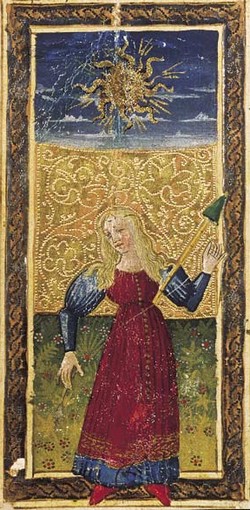
"Woman with spindle at Trionfi card "Sun", so-called Charles VI Tarot c. 1460, given to Florence
Wealth by Textiles
Again we meet in this text with Andrea Banchi a silk trader. Florentine wealth in 14th and 15th century depended mainly on the textile trade.
The figure "Woman with spindle" appears for the first time to our eyes in the Charles VI Tarot. Some Tarot researchers assume, that the figure presents one of the Three Fates, Clotho, who "... spun the thread of life from her distaff onto her spindle. Her Roman equivalent was Nona, (the 'Ninth'), who was originally a goddess called upon in the ninth month of pregnancy".
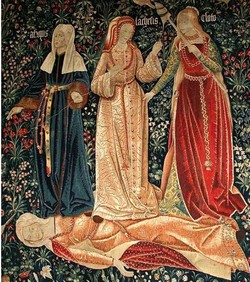
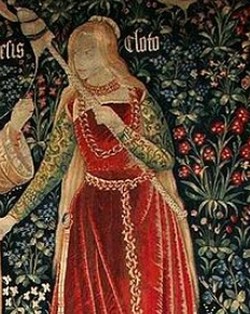
On the other hand the picture might just advertise "Florentine textile industry". From 21 guilds in Florence six were related to clothing production and 4 of them belonged to the 7 Arti Maggiori, the most important of them. Silk weavers and merchants had the 5th place in the ranking, wool manufactorer had the 3rd position.
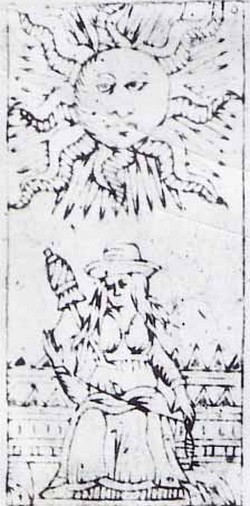
"Woman with spindle at Tarocchi card "Sun", Rothschild cards c. 1500, given to Bologna
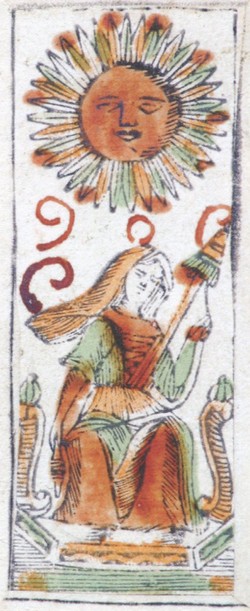
"Woman with spindle" at Bolognese card "Sun", 18th century
Bologna, also strongly dependent on the wool production, used the same motif in their Tarocchi and proceeded with it till the modern times.
|
|




